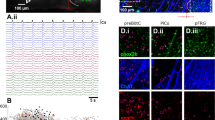Abstract
We examined the synaptic connections between ventral-group, bulbospinal inspiratory neurons in 27 vagotomized, paralyzed, ventilated, and decerebrated rats using cross-correlation and spike-triggered averaging of intracellular potentials. The neurons were recorded in the medulla about the level of the obex and identified by their inspiratory firing pattern and antidromic activation from the spinal cord at C7. Whole C5 phrenic nerve recordings were made using bipolar electrodes from the central cut ends of the nerve. Most (108/137, 79%) inspiratory neurons discharged only during inspiration but some (29/137, 21%) also discharged during early expiration. Their intracellular membrane potentials displayed a pattern of depolarization during inspiration, repolarization during early expiration, and hyperpolarization during late expiration. Intracellular chloride iontophoresis changed the inspiratory membrane potential trajectories from augmenting to decrementing in 11 of 19 neurons tested (58%), and demonstrated the presence of both early-decrementing and late-augmenting waves of inhibitory postsynaptic potentials during expiration in 11 of 19 neurons tested (58%). Cross-correlation histograms were computed between pairs of extracellularly recorded neurons to detect short time scale synchronizations indicative of synaptic connections (26 ipsilateral; 23 contralateral). While none of the cross-correlation histograms for contralateral pairs showed peaks, most (23, 88%) of those for ipsilateral pairs showed peaks (mean half-amplitude width ± SD = 1.3 ± 0.4 ms) at time zero suggestive of common activation. Some of the latter (6, 23%) showed troughs superimposed on the central peaks (mean half-amplitude width ± SD = 0.9 ± 0.2 ms) at short latencies (mean latency ± SD = 1.8 ± 1.9 ms) suggestive of inhibition; others (8, 31%) had asymmetrical central peaks and two had bilateral peaks suggesting more complex interconnections. Averages of intracellular membrane potentials of inspiratory neurons (n = 24), triggered by action potentials of a nearby extracellularly recorded inspiratory neuron, were computed to detect synchronized postsynaptic potentials. Over half (16, 67%) showed postsynaptic potentials (mean amplitude ± SD = 201 ± 176 μV; mean half-amplitude width ± SD = 2.3 ± 0.8 ms) confirming the cross-correlation findings of common excitation. We conclude that in decerebrated rats, ventral-group inspiratory neurons projecting to the C7 spinal segment share powerful, ipsilaterally distributed excitatory inputs which enhance their synchronous activity during inspiration. They also receive inhibition during inspiration and early-decrementing and late-augmenting inhibitory inputs during expiration.
Similar content being viewed by others
Author information
Authors and Affiliations
Additional information
Received: 25 October 1996 / Accepted: 21 March 1997
Rights and permissions
About this article
Cite this article
Tian, GF., Duffin, J. Synchronization of ventral-group, bulbospinal inspiratory neurons in the decerebrate rat. Exp Brain Res 117, 479–487 (1997). https://doi.org/10.1007/s002210050244
Issue Date:
DOI: https://doi.org/10.1007/s002210050244




